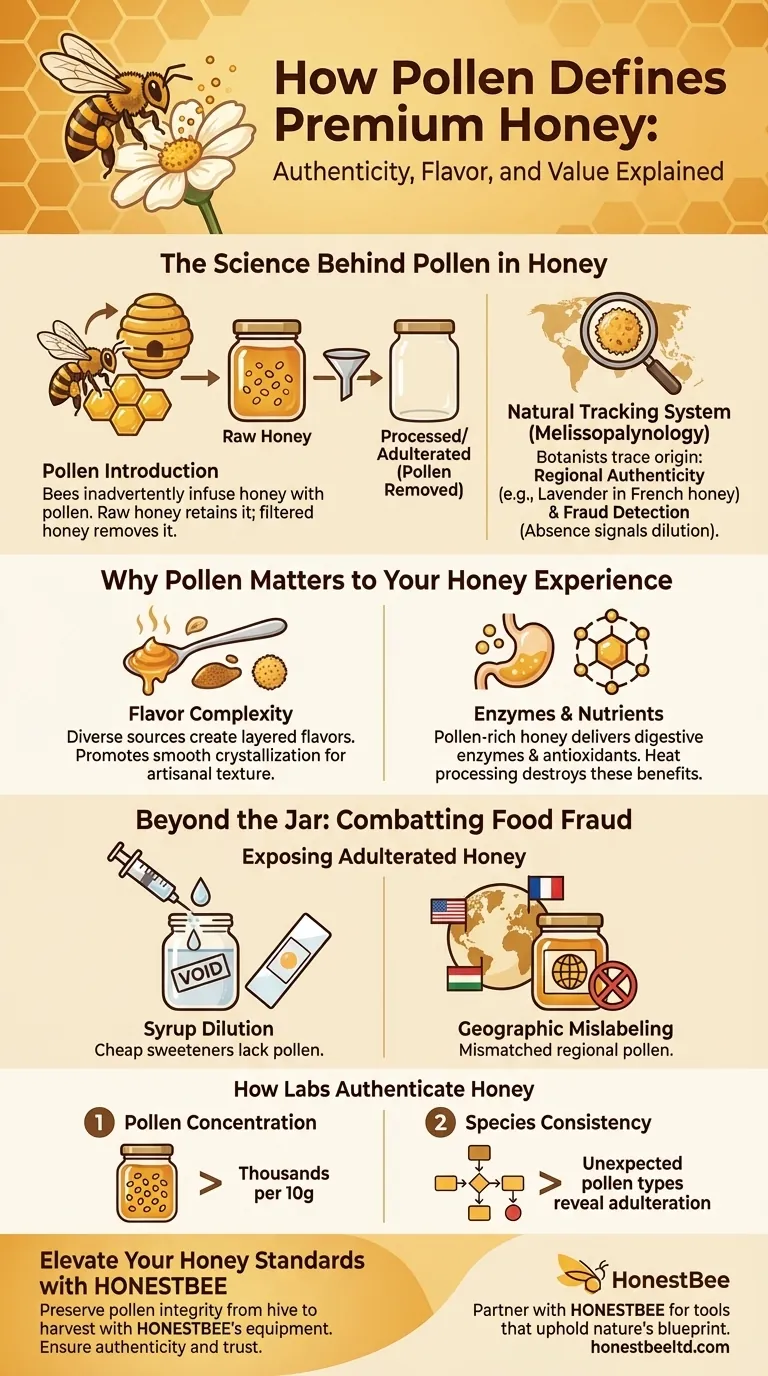For honey enthusiasts and health-conscious consumers, pollen isn’t just a natural byproduct—it’s the fingerprint of quality. This article reveals why pollen content justifies premium pricing, how it safeguards against fraud, and what it means for your culinary and nutritional experience.
The Science Behind Pollen in Honey
How Bees Introduce Pollen into Honey
Honeybees inadvertently infuse honey with pollen grains as they shuttle between flowers and hives. These microscopic particles, often invisible to the naked eye, carry distinct botanical signatures. Research shows that raw, unprocessed honey retains this pollen, while heavily filtered or adulterated products remove it—a red flag for quality.
Pollen as a Natural Tracking System
Botanists use pollen analysis (melissopalynology) to trace honey’s geographic origin. For example:
- Regional Authenticity: Lavender pollen in French honey or orange blossom pollen in Spanish varieties confirms local production.
- Fraud Detection: Absence of expected pollen (e.g., clover in "clover honey") signals dilution with syrups or foreign honey.
Pollen’s role extends beyond labeling accuracy; it’s nature’s anti-counterfeiting measure.
Why Pollen Matters to Your Honey Experience
Flavor Complexity Through Pollen Signatures
Pollen influences honey’s taste profile:
- Diverse Pollen Sources: Wildflower honey’s layered flavors stem from mixed pollen, while monofloral honey (like manuka) has a distinct, robust taste.
- Texture: As referenced in studies, pollen promotes smooth crystallization, enhancing mouthfeel—a hallmark of artisanal honey.
Enzymes and Nutrients Linked to Pollen
Pollen-rich honey delivers:
- Digestive Enzymes (e.g., amylase) that aid nutrient absorption.
- Antioxidants like flavonoids, which correlate with higher pollen counts.
Did you know? Heat processing destroys pollen-linked enzymes, diminishing honey’s health benefits.
Beyond the Jar: Pollen’s Role in Combating Food Fraud
Case Studies: Exposing Adulterated Honey
Labs routinely uncover fraud via pollen analysis:
- Syrup Dilution: Cheap sweeteners lack pollen, leaving a chemical "void" in tests.
- Geographic Mislabeling: Imported honey sold as "local" may mismatch regional pollen databases.
How Labs Authenticate Honey
Melissopalynology identifies:
- Pollen Concentration: Authentic honey contains thousands of grains per 10g.
- Species Consistency: Unexpected pollen types reveal adulteration.
For commercial buyers, pollen verification ensures wholesale honey meets label claims—protecting both reputation and consumer trust.
Elevate Your Honey Standards with HONESTBEE
Whether you’re a beekeeper prioritizing purity or a distributor sourcing premium honey, HONESTBEE’s equipment helps preserve pollen integrity—from hive to harvest. Explore our beekeeping supplies designed to maintain honey’s natural quality, ensuring every batch meets the gold standard of authenticity.
Ready to invest in pollen-rich honey production? Partner with HONESTBEE for tools that uphold nature’s blueprint.
Visual Guide

Related Products
- Natural Wood Honey Dipper for Tea Coffee and Desserts
- Easy Use Manual Stainless Steel Honey Press for Honey Comb
- Varroa Easy Check Mite Tester Kit Counter Alcohol Wash Jar
- Stainless Steel 3 Frame Manual Honey Extractor Spinner for Bee Honey Extraction
- 2 Frame Stainless Steel Manual Honey Spinner Extractor for Beekeeping
Related Articles
- Mastering Honey Refractometer Basics: A Guide to Precision and Profitability
- How to Harvest Honey Naturally: A Beekeeper’s Guide to Crush & Strain
- How to Prevent Honey Fermentation: The Science of Moisture Control for Beekeepers
- How to Purify Beeswax Contaminated with Brood Comb: Maximizing Honey Recovery
- How to Safely Restore Crystallized Honey Without Losing Nutrients




















